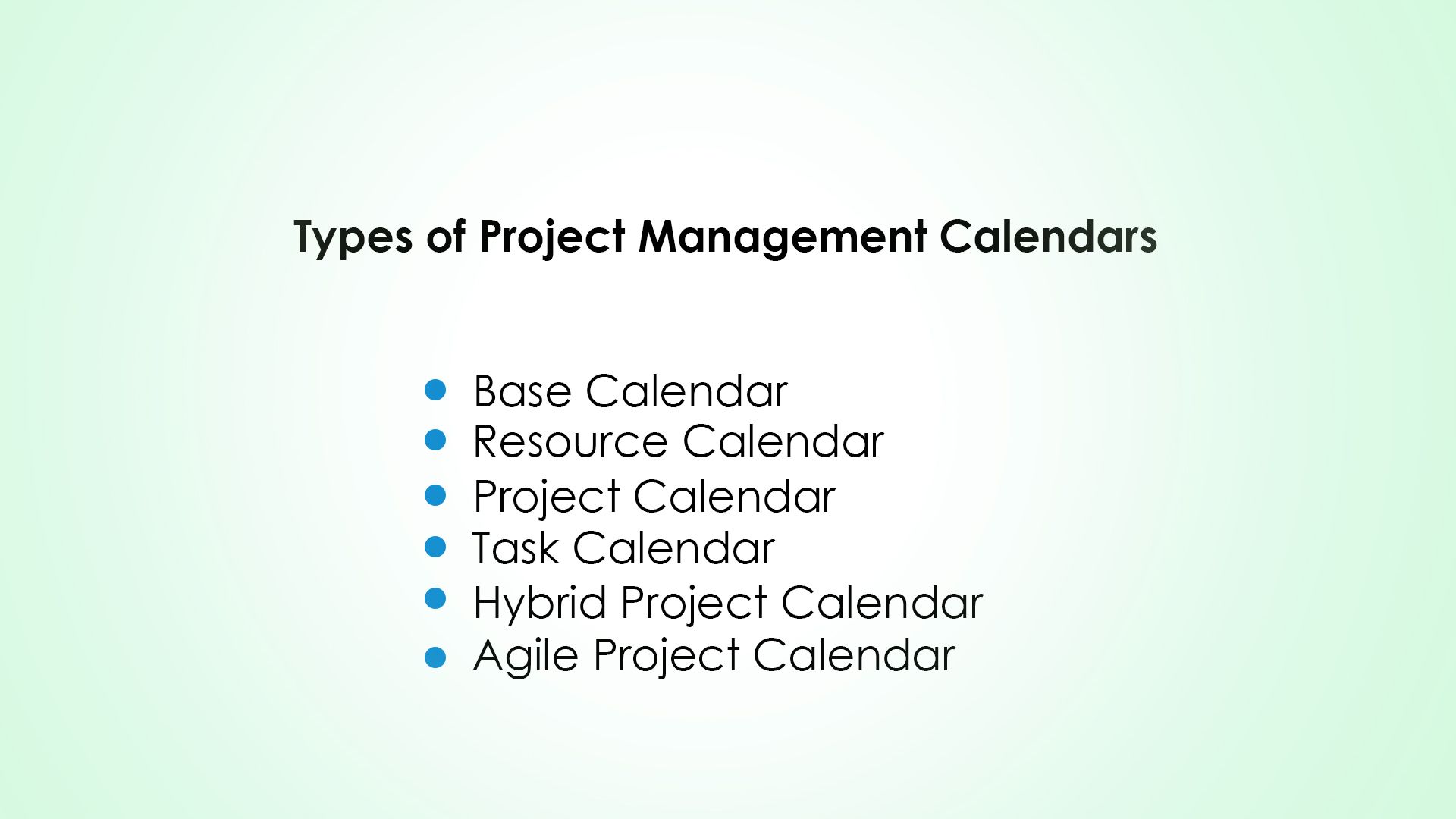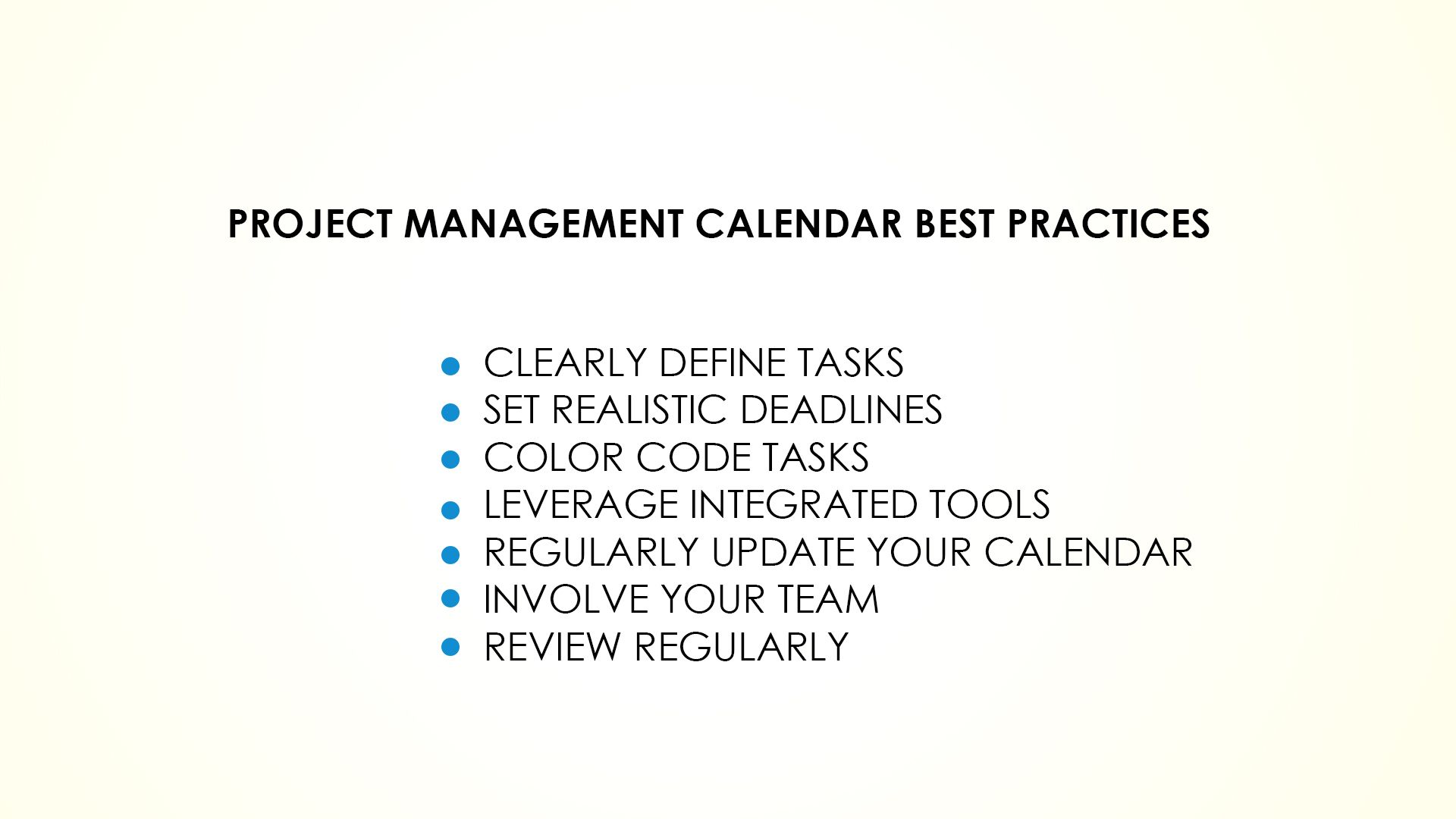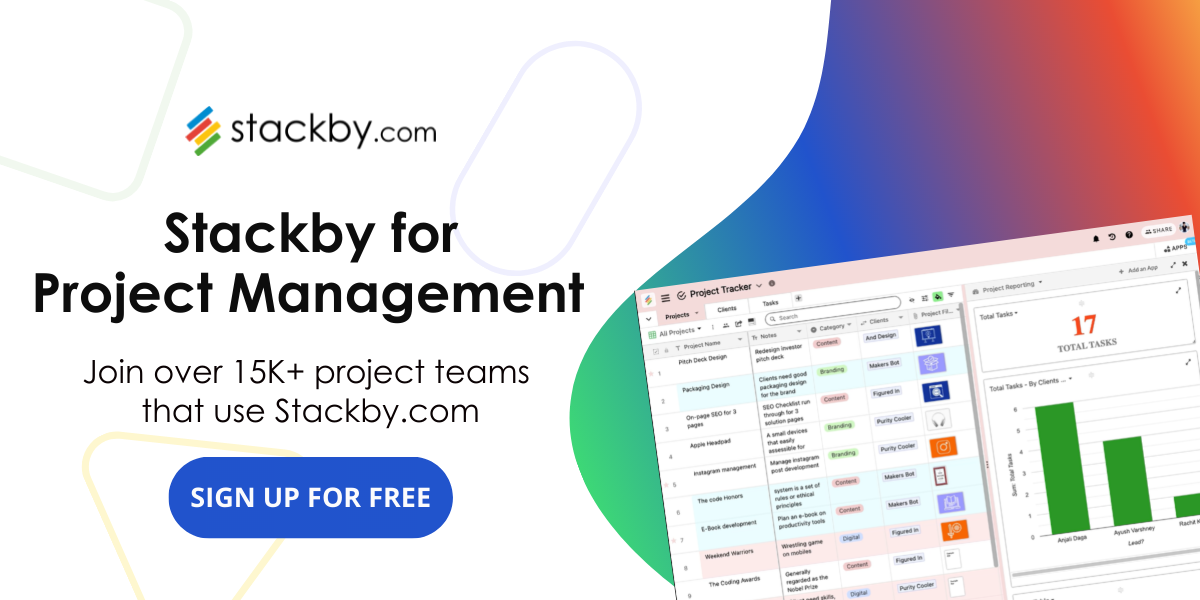How to Make a Project Management Calendar (With Tools & Templates)
Learn how to create an effective project management calendar with easy-to-use tools & templates to streamline your scheduling process.

Effective project management hinges on clear organization and timely execution. At the heart of this process lies the project management calendar – a vital tool that can significantly improve how you plan, execute, and monitor your projects. Whether you're an experienced project manager or new to the field, mastering the creation and use of a project management calendar can dramatically enhance your team's efficiency and project outcomes.
Imagine a project where every team member knows exactly what they should be working on, when deadlines are approaching, and how their tasks fit into the bigger picture. This level of clarity and coordination is what a well-implemented project management calendar can provide. It's not just about marking dates on a calendar; it's about creating a dynamic, visual roadmap for your entire project lifecycle.
In this guide, we'll explore the ins and outs of project management calendars, from understanding their core functions to implementing best practices. We'll also look at some of the best tools and templates available to help you get started quickly and efficiently. By the end, you'll be equipped with the knowledge to create a project management calendar that keeps your projects on track and your team aligned.
Best Project Management Software for Businesses to use in 2024
What is the Project Management Calendar?
A project management calendar is more than just a fancy to-do list with dates attached. It's a comprehensive visual representation of your project's timeline, tasks, milestones, and deadlines. Think of it as the heartbeat of your project, pulsing with the rhythm of daily activities, team assignments, and critical checkpoints.
At its core, a project management calendar serves several key purposes:typres
- Visualization: It provides a clear, at-a-glance view of your project's timeline.
- Task Management: It helps you allocate and track tasks across your team.
- Resource Planning: It allows you to manage resources effectively over time.
- Countdown Tracking: It keeps everyone aware of upcoming due dates and milestones.
- Communication: It serves as a central point of reference for the entire team.
But not all project management calendars are created equal. Let's dive into the different types you might encounter.
Types of Project Management Calendars

#1. Base Calendar
The base calendar is the foundation upon which other calendars are built. It typically includes:
- Standard working hours
- Weekends and non-working days
- Company holidays
Think of the base calendar as the skeleton of your project management system. It provides the basic structure that other, more specific calendars will flesh out.
#2. Resource Calendar
Resource calendars focus on the availability of specific resources, whether they're people, equipment, or facilities. These calendars help you:
- Track individual team member schedules
- Manage equipment usage and availability
- Optimize resource allocation across projects
For example, a resource calendar might show that Sarah from the design team is on vacation for a week in July, allowing you to plan around her absence.
#3. Project Calendar
The project calendar is where the rubber meets the road. It's specific to a single project and includes:
- Project start and end dates
- Key milestones and deliverables
- Task deadlines
- Team meetings and check-ins
This calendar gives you a comprehensive view of everything related to a particular project, helping you stay on top of progress and deadlines.
#4. Task Calendar
Task calendars drill down to the nitty-gritty of individual tasks. They typically include:
- Detailed task descriptions
- Start and end dates for each task
- Task dependencies
- Assigned team members
These calendars are crucial for day-to-day project management, ensuring that every team member knows what they should be working on and when.
#5. Hybrid Project Calendar
As the name suggests, hybrid project calendars combine elements of different calendar types. They might incorporate:
- Project-specific timelines
- Resource availability
- Task breakdowns
Hybrid calendars are versatile and can be customized to fit the unique needs of your project and team.
#6. Agile Project Calendar
For teams using Agile methodologies, Agile project calendars are essential. These typically feature:
- Sprint timelines
- Daily stand-up meeting schedules
- Sprint planning and review sessions
- Product backlog items
Agile calendars help teams stay nimble and responsive, adapting to changes as they arise throughout the project lifecycle.
Checkout Our Customer Journey with Project Management in Stackby
Benefits of Using Project Management Calendar Templates
Now that we've explored the types of project management calendars, let's look at why using templates can supercharge your project planning process.

#1. Improve Resource Management
Project management calendar templates can significantly enhance your resource management by:
- Providing a clear overview of resource allocation
- Highlighting potential conflicts or overallocation
- Facilitating better long-term resource planning
With a well-designed template, you can ensure that your team's skills and time are used efficiently, avoiding burnout and maximizing productivity.
#2. Task Scheduling
Effective task scheduling is at the heart of successful project management. Calendar templates help you:
- Break down complex projects into manageable tasks
- Set realistic timelines for each task
- Visualize task dependencies and critical paths
By using a template, you can create a rhythm for your project, ensuring that tasks flow smoothly from one to the next.
#3. Time Management
Time is often the most precious resource in project management. Calendar templates assist with time management by:
- Clearly defining project phases and deadlines
- Helping team members prioritize their work
- Identifying potential time-wasters or bottlenecks
With a good project management calendar template, you can make every minute count towards project success.
Project Management Calendar Best Practices

Creating a project management calendar is one thing; using it effectively is another. Here are some best practices to help you make the most of your calendar:
1. Clearly Define Tasks
When adding tasks to your calendar, be as specific as possible. Instead of "Work on report," try "Draft executive summary for Q2 report." Clear task definitions help:
- Avoid misunderstandings
- Make progress easier to track
- Enable more accurate time estimations
2. Set Realistic Deadlines
While it's tempting to set ambitious deadlines, unrealistic timelines can lead to stress and burnout. When setting deadlines:
- Consider past project data
- Account for potential obstacles
- Build in buffer time for unexpected issues
Remember, a realistic deadline met is better than an unrealistic one missed.
3. Color Code Tasks
Visual cues can make your calendar much more user-friendly. Consider color-coding tasks based on:
- Project phase
- Team or department
- Priority level
- Task status
For example, you might use red for high-priority tasks, yellow for medium priority, and green for low priority.
4. Leverage Integrated Tools
Your project management calendar doesn't exist in a vacuum. Integrate it with other tools like:
- Communication platforms (e.g., Slack)
- File sharing systems (e.g., Google Drive)
- Time tracking software
This integration creates a seamless workflow, reducing the need to switch between multiple applications.
Streamline your project schedules with an alternative to google sheets such as Stackby, which adds drag-and-drop, calendar, and collaboration features.
5. Regularly Update Your Calendar
A project management calendar is a living document. Make sure to:
- Update task statuses regularly
- Adjust timelines as needed
- Add new tasks or milestones as they arise
Regular updates ensure that your calendar remains an accurate representation of your project's status.
6. Involve Your Team
Your project management calendar should be a collaborative tool. Encourage team involvement by:
- Allowing team members to update their own tasks
- Seeking input on timelines and deadlines
- Using the calendar as a reference point in team meetings
Team involvement leads to better buy-in and more accurate planning.
7. Review Regularly
Set aside time to regularly review your project management calendar. This might involve:
- Weekly team check-ins
- Monthly progress reviews
- End-of-project retrospectives
Regular reviews help you stay on track and learn from both successes and challenges.
3 Best Free & Affordable Tools for Project Management Calendar

Now that we've covered the basics, let's look at some tools that can help you create and manage your project calendar effectively.
#1. Stackby 300+ Database Calendar

Stackby offers a powerful and flexible solution for project management calendars. It combines the ease of spreadsheets with the power of sync databases, making it an excellent choice for teams of all sizes.
Why You Should Use Stackby Calendar Templates:
- Customizable to fit your specific project needs
- Integrates seamlessly with other Stackby features
- Offers a visual, intuitive interface
- Provides real-time collaboration capabilities
Pricing: Stackby offers a range of plans to suit different needs:
- Free plan available for small teams
- Paid Personal plans start at $5/month for individuals
- Small Team Economy plans from $9/user/month
- Growing Team Business Plan $18/user/month
- Powered Pack Business Plus Plan $35/user/month
- Let's Connect For Enterprise Plan - Free Demo with Free Plan
#2. ClickUp

ClickUp is a comprehensive project management tool that includes robust calendar features.
Small Introduction: ClickUp's calendar view allows you to visualize tasks, set due dates, and manage your project timeline all in one place. It offers multiple calendar views and integrates well with other ClickUp features.
Pricing:
- Free plan available with limited features
- Paid plans start at $5/user/month
- Business plans from $12/user/month
#3. Google Calendar

While not a dedicated project management tool, Google Calendar can be an effective option for smaller projects or teams already using Google Workspace.
Small Introduction: Google Calendar offers a familiar interface and excellent integration with other Google tools. It's simple to use and great for basic project scheduling needs.
Pricing:
- Free for personal use
- Part of Google Workspace plans for businesses, starting at $6/user/month
Free Ready to Use Project Management Calendar Templates

To help you get started quickly, here are some free project management calendar templates you can use:
1. Marketing Project Management Calendar Template
This template is designed to help marketing teams plan and execute campaigns effectively. It includes:
- Campaign timelines
- Content deadlines
- Performance tracking metrics
2. Digital Content Project Management Calendar Template
Perfect for content creators and digital marketers, this template helps manage:
- Content ideation
- Creation deadlines
- Publication schedules
- Distribution plans
3. Email Marketing Project Management Calendar Template
For teams focused on email marketing, this template covers:
- Email campaign planning
- A/B testing schedules
- Performance analysis timelines
4. Social Media Project Management Calendar Template
Social media managers will find this template useful for:
- Planning post schedules across platforms
- Managing content creation workflows
- Tracking engagement metrics
5. B2B Project Management Content Calendar Template
Tailored for B2B marketers, this template includes:
- Long-form content planning
- Lead generation campaign timelines
- Sales enablement material schedules
👉 To complement your project calendars, use the project tracker template for detailed task allocation and real-time project monitoring.
Conclusion: Create Your Project Management Calendar Templates with Stackby
As we've explored, project management calendars are essential tools for keeping your projects on track and your team aligned. While there are many tools and templates available, creating a calendar that truly fits your team's needs often requires a customizable, flexible solution.
This is where Stackby shines. With Stackby, you can:
Visit our Templates page to start with pre‑built project management calendar templates
- Start with one of the ready-made templates we've discussed
- Customize it to fit your specific project requirements
- Integrate it with other project management tools you use
- Collaborate with your team in real-time
- Visualize your project timeline in multiple views
Remember, the best project management calendar is one that your team will actually use. By leveraging Stackby's intuitive interface and powerful features, you can create a calendar that not only keeps your projects on track but also enhances team collaboration and productivity.
So why wait? Start building your perfect project management calendar with Stackby today. Your future, well-organized, deadline-crushing self will thank you!
For a full list of project and workflow templates, visit the Stackby templates page.

This article was originally published in September 2024 by Stackby Content Team. The most recent update was in July 2025.

![Step by Step Guide on How to Build Forms in a Database [2026]](/blog/content/images/2022/03/form-database-blog.png)


